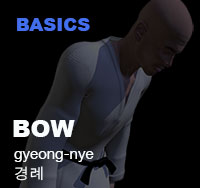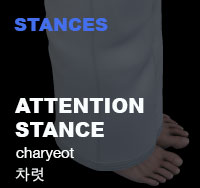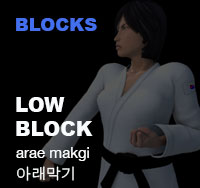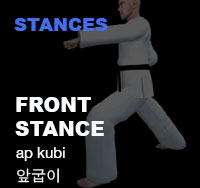- Poomse 품새
- Kibon Basic #1 Pattern
Taekwondo 태권도Taekwondo Preschool
Promotion from one geup to the next can proceed rapidly in some schools, since schools often allow geup promotions every two, three, or four months. Students of geup rank learn the most basic techniques first, and then move on to more advanced techniques as they approach first dan. Many of the older and more traditional schools often take longer to allow students to test for higher ranks than newer, more contemporary schools, as they may not have the required testing intervals. View Taekwondo belt levels »

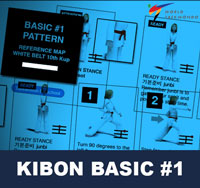


Kibon Basic #1 Pattern
Poomse is the foundation for the teaching of taekwondo. A poomse or form is a detailed pattern of defense-and-attack motions and techniques used in traditional martial arts. Poomse is useful in developing proper kinetics, mental and physical fortitude.
Kibon Basic #1 Pattern
Meaning: Beginning
Movements: 20
Difficulty Level: Beginner
Grade Level: 10th Geup
Style: World Taekwondo (WT) » 
In World Taekwondo (WT) style, Kibon Basic #1 is the first poomse a beginner practitioner will likely learn when starting at 'White Belt ( 10th geup )' level. The taekwondo practitioner will learn the basic foundations and understandings of poomse 품새 such as stance ( 서기 sogi ), techniques, balance, speed, and power. The following list below are some of the techniques learned;
- Low Block ( 아래막기 arae-makgi )
- Middle Punch ( 몸통 반대 지르기 momtong-bandae-jireugi )
- Attention Stance ( 차렷 charyeot )
- Ready Stance ( 기본준비 junbi )
- Front Stance ( 앞굽이 ap-kubi )
A practitioners presence on the mat must be as credible as their technique. Self belief, confidence in abilities, and intention to perform to a personal best are tangible virtues considered indispensable in taekwondo practitioners.
Training Methods
How well one improves with training depends on several factors, such as the frequency it is engaged in, and the type of feedback that is available for improvement. If a student does not train often enough, reinforcement fades, and he or she is likely to forget what was learned for the poomse.
When learning the poomse, it is helpful to use mirrors to observe your techniques and fix your mistakes immediately. Initially, a student may need focused feedback from a certified Master Instructor ( 사범님 sabeomnim ); however, as they progress, they must develop the ability to self-assess the poomse.
Difficulty of Poomse
Taekwondo students of geup ranking learn the most basic techniques first, and then move on to more advanced and difficult techniques as they approach 1st Dan Black Belt. The more difficult the techniques, the more practice may be needed for the purpose of improving or mastering it, as in the phrase 'practice makes perfect'. Every poomse must display the requisite speed, balance, power and firmness to be realistically used as an attack or defense move.
* Please see a certified Master Instructor ( 사범님 sabeomnim ) for training. Proper guidance and instructions are needed to ensure safe training.
Techniques Included in this Poomse
Both basic and advanced taekwondo techniques can be contained within a single pattern and the higher the level of the practitioner, the greater the difficulty of the techniques and the complexity of the pattern. Remember a poomse is a detailed pattern of defense-and-attack motions and techniques used in traditional martial arts. View more information Poomse »
Advertisement


Kibon Basic #1
Key Points in this Poomse
- Accuracy. Patterns should begin and end in the same place.
- Posture. Practitioners must have their body weight correctly distributed during each different stance ( 서기 sogi ) and during footwork ( 딛기 ditgi ). Each technique must be correctly aligned.
- Realism. Taekwondo patterns are the learning ground for real combat. As such, every technique must display the requisite speed, power and firmness to be realistically used as an attack or defense move.
- Spirit. A competitor's 'presence' on the mat must be as credible as his/her technique. Self belief, confidence in abilities, and intention to perform to a personal best are tangible virtues considered indispensable in taekwondo practitioners.
- Decorum. Proper manners must be displayed when interacting with the judges directly before and after the pattern. Respect must also be extended to rival competitors, clubs and other officials.
- Form. General qualities that judges look for in any taekwondo practitioner include proper breathing technique and body control. The diaphragm must be engaged in deep breathing, shallow breathing concentrated in the upper abdomen results in raised shoulders and stressed muscles. The muscles of the body should be lightly relaxed in order to perform the pattern with fluidity, speed and grace. Muscles should only be tensed at the moment of imaginary impact in order to commute maximum power to any individual taekwondo technique.


Kibon Basic #1
Promotion Tests Requirement
Students often undergo periodic testing and grading by their own Master Instructor ( 사범님 sabeomnim ) in order to advance to a higher level of recognized achievement such as a different belt color. They need to demonstrate their proficiency in the various aspects of the art such as the execution of patterns ( 품새 poomse ), which combine various techniques in specific sequences.
Kibon Basic #1 is a requirement for the below belt levels (Varies between schools). Promotion from one belt level to the next can proceed rapidly in some schools, since schools often allow geup promotions every two, three, or four months. Students of geup rank learn the most basic techniques first, and then move on to more advanced techniques as they approach first dan black belt. View Promotion Tests »
Use in Demonstrations
To promote taekwondo for its emphasis on high kicking and fast hand techniques, taekwondo schools perform at tournaments, community events, shopping malls, parks, and tv shows. Demonstrations vary from school to school, but may include such elements as the execution of poomse ( 품새 poomse ), which combine various techniques in specific sequences; the breaking of boards to demonstrate the ability to use techniques with both power and control; sparring ( 겨루기 gyeorugi ) and self-defense ( 호신술 hosinsool ) to demonstrate the practical application and control of techniques; physical fitness usually with push-ups and sit-ups. For more information on Demonstrations »
( Click image for additional information)
Advertisement
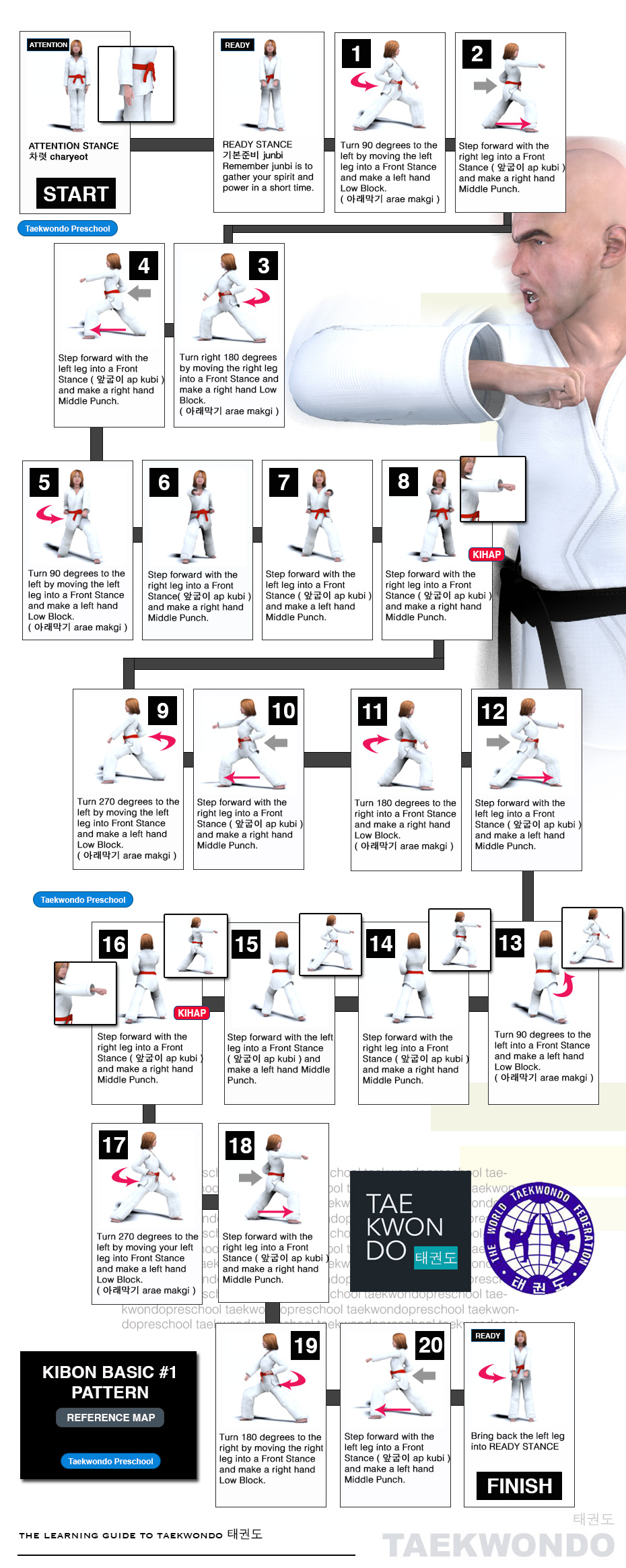

Quiz
Question. What is the name of Taegeuk #8 in Korean?
Taegeuk 태극 (in World Taekwondo (WT)) refers to a set of poomse 품새 used to create a foundation for the teaching of taekwondo. A poomse or form is a detailed pattern of defense-and-attack motions and techniques used in traditional martial arts. Each taegeuk form symbolizes a specific state thought to be indicative of the belt the student currently holds, and is represented in World Taekwondo (WT) by trigrams similar to those found in the four corners of the South Korean flag.
Question. What is the name of Taegeuk #8 in Korean?
Answer you gave was: Chil Jang
Your answer is wrong! You need to study more!


The trigram associated with this poomse represents a Mountain. Also, it represents the northwest and youngest son. The symbolism behind the mountain is the indomitable and majestic nature that all mountains possess. This poomse is intended to be performed with the feeling that all movements are this majestic due to their unconquerable nature.
Question. What is the name of Taegeuk #8 in Korean?
Answer you gave was: Yuk Jang
Your answer is wrong! You need to study more!


The trigram associated with this poomse represents Water. Also, there is a relation to West and the relationship with a Second son. The movements of this poomse are intended to be performed like water; flowing, powerful and cleansing. Sometimes standing still like water in a lake, sometimes thriving as a river, sometimes powerful like a waterfall.
Question. What is the name of Taegeuk #8 in Korean?
Answer you gave was: Sam Jang
Your answer is wrong! You need to study more!


This trigram represents Fire. Related to this symbol is also East and the relationship of the Second Daughter. Fire contains a lot of energy. The symbol behind the fire is similar to the symbolism of the water in that both can aid and both can destroy. This form is intended to be performed rhythmically, with some outbursts of energy to reflect fire's rhythmic and energetic dualism.
Question. What is the name of Taegeuk #8 in Korean?
Answer you gave was: Pal Jang
Your answer is correct! Great Job!


The trigram associated with this poomse represents the Earth. Also, there is a representation of North and Mother. The associated trigram of this poomse is Yin. Yin, here, represents the end of the beginning, the evil part of all that is good. This being the last of the poomse Taegeuk, it represents the end of the circle and the cyclic nature of the Earth.
Question. What is the korean terminology for Back Stance?
Back stance is specifically focused on shifting weight to the back leg, as it offers much more control, and makes it easier to kick off the front leg. To perform this stance, the body faces to the side, with the front foot facing forward and the front leg bent. The back leg is bent slightly and the foot is turned outwards perpendicular to the front foot making the letter "L" for this stance.
Question. What is the korean terminology for Back Stance?
Answer you gave was: ( 뒷굽이 dwi kubi )
Your answer is correct! Great Job!

Back Stance ( 뒷굽이 dwi kubi ) is specifically focused on shifting weight to the back leg, as it offers much more control, and makes it easier to kick off the front leg. To perform the Back Stance ( 뒷굽이 dwi-kubi ), the body faces to the side, with the front foot facing forward and the front leg bent. The back leg is bent slightly and the foot is turned outwards perpendicular to the front foot making the letter "L" for this stance ( 서기 sogi ).
Question. What is the korean terminology for Back Stance?
Answer you gave was: ( 주춤서기 juchum sogi )
Your answer is wrong! You need to study more!

The Horse-Riding Stance ( 주춤서기 juchum-sogi ) is a beginner stance ( 서기 sogi ) generally used to practice punches ( 지르기 jireugi ) and blocks ( 막기 makgi ). It is similar to the Ready Stance ( 기본준비 junbi ) but the feet are placed much wider, about two-foot length's apart. Also, the knees ( 무릎 mureup ) are deeply bent and the shins ( 정강이 jeonggangi ) should be kept slightly perpendicular to the floor.
Question. What is the korean terminology for Back Stance?
Answer you gave was: ( 앞굽이 ap kubi )
Your answer is wrong! You need to study more!

Front Stance ( 앞굽이 ap-kubi ) is one of the most important techniques to learn when starting taekwondo as a beginner. The distance between the inside edges or namely the Reverse Foot Blade ( 발날등 balnaldeung ) of both feet should be between one to two fists apart and is about 4 to 4 one-half foot-length from origin. Rear toes are turned outward about 30 degrees and the body is also naturally angled at 30 degrees or facing straight forward depending on the upper body technique.
Question. What is the korean terminology for Back Stance?
Answer you gave was: ( 앞서기 ap sogi )
Your answer is wrong! You need to study more!

The Walking Stance ( 앞서기 ap-sogi ) is a beginner stance ( 서기 sogi ) that is used to approach or retreat in combat and patterns ( 품새 poomse ). Feet should be maintained approximately 3 foot-length from origin. To maintain a solid base, the front foot is facing straight forward and the back foot is 30 degrees to aid balance. Use of this stance ( 서기 sogi ) is featured prominently in many of the World Taekwondo (WT) Poomse.
Question. What is the korean terminology for Self-Defense?
Self-Defense is a countermeasure that involves defending the health and well-being of oneself from harm. Self-defense techniques and recommended behavior under the threat of violence is systematically taught in self-defense classes. It forms one of the main principles of the taekwondo art.
Question. What is the korean terminology for Self-Defense?
Answer you gave was: ( 지르기 jireugi )
Your answer is wrong! You need to study more!


Taekwondo Fist Strikes ( 지르기 jireugi ) are performed as a close distance alternative to kicks ( 차기 chagi ). They are executed in a number of ways - from standing, jumping, spinning and rushing forwards. The striker relaxes to the extent possible during the strike, tensing the muscles of much of the body only at the time of impact, then relaxing again to recoil the striking part. Hand strikes make up fast combinations of strikes which can leave an opponent stunned and unable to defend himself most commonly in self defense ( 호신술 hosinsool ) applications.
Question. What is the korean terminology for Self-Defense?
Answer you gave was: ( 서기 sogi )
Your answer is wrong! You need to study more!


The Korean martial arts has several Stances ( 서기 sogi ) used for different activities. Although there are strong similarities in stances throughout taekwondo schools, individual instructors often have their own preferred style. These stances are most commonly seen in taekwondo forms, and are critical for balance, precision, and good technique in the martial art.
Question. What is the korean terminology for Self-Defense?
Answer you gave was: ( 호신술 hosinsool )
Your answer is correct! Great Job!
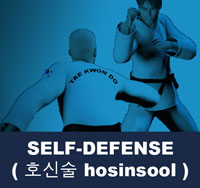

Self-Defense ( 호신술 hosinsool ) is a countermeasure that involves defending the health and well-being of oneself from harm. Self-defense techniques and recommended behavior under the threat of violence is systematically taught in self-defense ( 호신술 hosinsool ) classes. It forms one of the main principles of the taekwondo art. The self-defense ( 호신술 hosinsool ) applications would be difficult to score in sparring as they are designed primarily to cause injury or quickly incapacitate an adversary.
Question. What is the korean terminology for Self-Defense?
Answer you gave was: ( 치기 chigi )
Your answer is wrong! You need to study more!


Taekwondo Strikes ( 치기 chigi ) are performed as a close distance alternative to kicks. Hand strikes make up fast combinations of strikes which can leave an opponent stunned and unable to defend himself. Striking ( 치기 chigi ) are taekwondo techniques striking with the twisting force of the body excluding techniques using the fist ( 주먹 jumeok ) or fingertips ( 손끝 sonkkeut ).
Question. What is the name of Taegeuk #7 in Korean?
Taegeuk 태극 (in World Taekwondo (WT)) refers to a set of poomse 품새 used to create a foundation for the teaching of taekwondo. A poomse or form is a detailed pattern of defense-and-attack motions and techniques used in traditional martial arts. Each taegeuk form symbolizes a specific state thought to be indicative of the belt the student currently holds, and is represented in World Taekwondo (WT) by trigrams similar to those found in the four corners of the South Korean flag.
Question. What is the name of Taegeuk #7 in Korean?
Answer you gave was: Yuk Jang
Your answer is wrong! You need to study more!


The trigram associated with this poomse represents Water. Also, there is a relation to West and the relationship with a Second son. The movements of this poomse are intended to be performed like water; flowing, powerful and cleansing. Sometimes standing still like water in a lake, sometimes thriving as a river, sometimes powerful like a waterfall.
Question. What is the name of Taegeuk #7 in Korean?
Answer you gave was: Sa Jang
Your answer is wrong! You need to study more!


This trigram represents Thunder. Also, the trigram is strongly connected to northeast and the relationship of the Eldest son. Thunder comes from the sky and is absorbed by the earth, thus, according to the beliefs of the I Ching, thunder is one of the most powerful natural forces. This poomse is associated with power and the connection between the heavens and earth.
Question. What is the name of Taegeuk #7 in Korean?
Answer you gave was: O Jang
Your answer is wrong! You need to study more!


The trigram associated with this poomse represents Wind. The trigram is also related to southwest and the relationship with an eldest daughter. The I Ching promotes that wind is a gentle force, but can sometimes be furious, destroying everything in its path. As such, it is intended that this poomse is performed like the wind: gently, but knowing the ability of mass destruction with a single movement.
Question. What is the name of Taegeuk #7 in Korean?
Answer you gave was: Chil Jang
Your answer is correct! Great Job!


The trigram associated with this poomse represents a Mountain. Also, it represents the northwest and youngest son. The symbolism behind the mountain is the indomitable and majestic nature that all mountains possess. This poomse is intended to be performed with the feeling that all movements are this majestic due to their unconquerable nature.



Taegeuk 태극 Poomse
Taegeuk 태극 (in World Taekwondo (WT)  ) refers to a set of poomse 품새 used to create a foundation for the teaching of taekwondo. A poomse or form (represented by 形 or 型) is a detailed pattern of defense-and-attack motions and techniques used in traditional martial arts. The word taeguek refers to the important principle in east Asian Taoist thought of the union of yin and yang. Each taegeuk form symbolizes a specific state thought to be indicative of the belt the student currently holds, and is represented in World Taekwondo (WT) by trigrams similar to those found in the four corners of the South Korean flag. View more information about Taegeuk 태극 Poomse ».
) refers to a set of poomse 품새 used to create a foundation for the teaching of taekwondo. A poomse or form (represented by 形 or 型) is a detailed pattern of defense-and-attack motions and techniques used in traditional martial arts. The word taeguek refers to the important principle in east Asian Taoist thought of the union of yin and yang. Each taegeuk form symbolizes a specific state thought to be indicative of the belt the student currently holds, and is represented in World Taekwondo (WT) by trigrams similar to those found in the four corners of the South Korean flag. View more information about Taegeuk 태극 Poomse ».
General qualities that judges look for in any taekwondo practitioner include proper breathing technique and body control. The diaphragm must be engaged in deep breathing, shallow breathing concentrated in the upper abdomen results in raised shoulders and stressed muscles. The muscles of the body should be lightly relaxed in order to perform the pattern with fluidity, speed and grace. Muscles should only be tensed at the moment of imaginary impact in order to commute maximum power to any individual taekwondo technique. For more information View Key Points »
RESOURCES
This article uses material from the Wikipedia article "List of Taekwondo Techniques", which is released under the Creative Commons Attribution-Share-Alike License 3.0.


